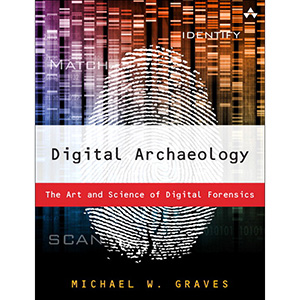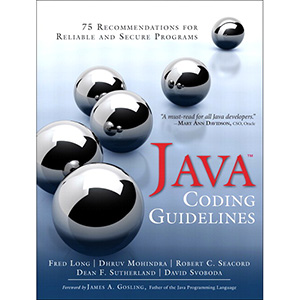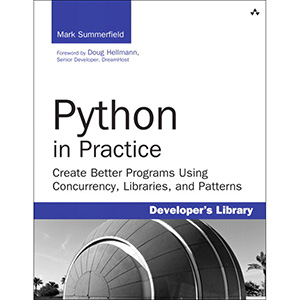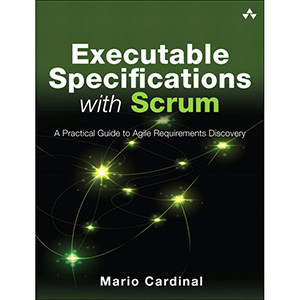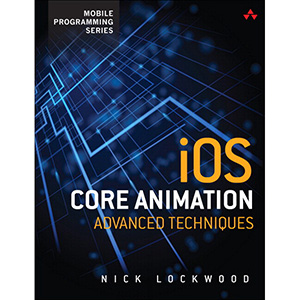| Murach’s Visual Basic 2012, 5th Edition Posted: 31 Dec 2013 02:52 AM PST 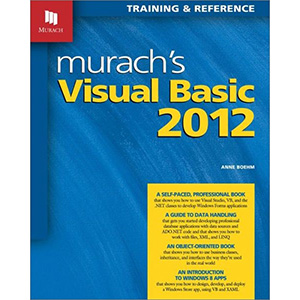
Book Description Ever since we published the first edition of our Visual Basic .NET book back in 2002, we’ve been getting comments like these: “Your Visual Basic book is so good, I opened it and did the whole application from scratch (even though I’d never tried VB before).” “I can’t praise this book highly enough. The clarity Anne uses in picking what to include, when to introduce it, and how to do so is remarkable.” “Had I bought your VB book first, I would have saved myself lots of dollars and several months’ time.” Now, Anne Boehm continues this tradition of quality and usefulness in the latest edition of our VB text, written for Visual Basic 2012. Of course, the content continues to evolve with the language. So in this edition, Anne has added a chapter on Windows 8 programming that gets you started creating touchscreen applications for tablets. And she’s updated the material wherever VB 2012 differs from earlier releases. But she hasn’t changed the overall approach. So whether you’re new to VB development…or you’re upgrading to VB 2012 and need an up-to-date reference…you’ll find that this book is packed with the information you need, delivered in a way that’s made earlier editions such favorites among professional developers: - It’s concise, practical, and crystal-clear in telling you what you need to know.
- It shows you how to get the most from Visual Studio 2012 as you design, code, debug, and deploy Windows Forms applications using VB 2012.
- It gives you solid training in the essential skills that you’ll use every day, including data validation…handling numeric, date, and string data…working with arrays and collections…handling exceptions…working with text, binary, and XML files…and understanding how OOP works.
- It gives you a 4-chapter section on database programming…far more than you’ll find in any other VB book, even though database handling is essential in business applications.
- It introduces you to LINQ, the .NET feature that lets you use VB to query almost any data source, from databases to arrays to XML files.
- It shows you how to build real-world applications so you always see how the features you’re learning interact with each other.
- It gives you chapter exercises that let you practice what you’re learning and apply your skills in new ways.
In short, if you’re going to be working with Visual Basic 2012, take the advice of your fellow developers: Save yourself some time and money by making this book your first choice for VB 2012 education and reference. Who this book is for
This book is for anyone who wants to learn how to use VB 2012 to develop Windows Forms applications: - If you’ve never used VB before, you’ll start at the beginning but move at a pace that has you developing business applications in a minimum of time.
- If you’re new to the .NET environment, you’ll learn how to use Visual Studio 2012 and all of the great productivity tools it has to offer as you learn Visual Basic.
- If you have experience with a previous version of Visual Basic, you’ll upgrade easily to VB 2012, focusing on the features and development techniques that are new to you.
And even though the focus is on Windows Forms, the skills you’ll gain will apply to any .NET application…whether for Windows, the web, or mobile devices. Table of Contents
Section 1: Introduction to Visual Basic programming
Chapter 1. An introduction to Visual Studio
Chapter 2. How to design a Windows Forms application
Chapter 3. How to code and test a Windows Forms application Section 2: The Visual Basic language essentials
Chapter 4. How to work with numeric and string data
Chapter 5. How to code control structures
Chapter 6. How to code procedures and event handlers
Chapter 7. How to handle exceptions and validate data
Chapter 8. How to work with arrays and collections
Chapter 9. How to work with dates and strings
Chapter 10. More skills for working with Windows forms and controls
Chapter 11. How to create and use classes
Chapter 12. How to debug an application Section 3: Database programming
Chapter 13. An introduction to database programming
Chapter 14. How to work with data sources and datasets
Chapter 15. How to work with bound controls and parameterized queries
Chapter 16. How to use ADO.NET to write your own data access code Section 4: Object-oriented programming
Chapter 17. How to work with default properties, events, and operators
Chapter 18. How to work with inheritance
Chapter 19. How to work with interfaces and generics
Chapter 20. How to organize and document your classes Section 5: More skills for working with data
Chapter 21. How to work with files and data streams
Chapter 22. How to work with XML files
Chapter 23. How to use LINQ Section 6: Enhancement, deployment, and Windows 8
Chapter 24. How to enhance the user interface
Chapter 25. How to deploy an application
Chapter 26. An introduction to Windows 8 programming Resources:
Appendix A. How to install and use the software and files for this book Book Details - Paperback: 842 pages
- Publisher: Mike Murach & Associates; 5th Edition (November 2013)
- Language: English
- ISBN-10: 1890774731
- ISBN-13: 978-1890774738
Note: There is a file embedded within this post, please visit this post to download the file. Related Books The post Murach’s Visual Basic 2012, 5th Edition appeared first on Wow! eBook. |
| Murach’s ASP.NET 4.5 Web Programming with VB 2012, 5th Edition Posted: 31 Dec 2013 02:47 AM PST 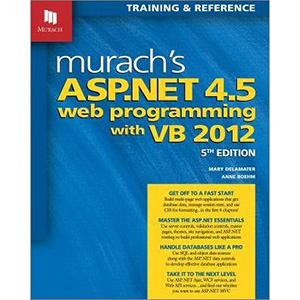
Book Description If you know how to create Windows applications using Visual Basic, you’re ready for this latest edition of our classic web programming book. It will get you off to a fast start with web programming, no matter whether you’re coming to ASP.NET 4.5 with a background in an earlier release of ASP.NET, Java servlets/JSP, PHP…or with no web background at all. In fact, by the end of chapter 5, you’ll know how to use Visual Studio 2012 to develop and test multi-page database applications for the web. But this book is much more than a beginning book. By the time you’re done, you’ll have the professional skills you need to develop bullet-proof web applications for business. You’ll also find that this book does double duty as the best on-the-job reference book that money can buy. Everything you need to know to get going on web development Look at the table of contents, and you’ll see why we say that this book covers what you need to know to develop web applications at the professional level. That includes skills like: - Managing state
- Validating input data
- Handling database data with SQL and object data sources, as well as with time-saving data controls like GridView, DetailsView, FormView, ListView, and DataPager
- Knowing how HTML5 and CSS3 fit into ASP.NET applications, so you can tweak that code as needed
- Creating user-friendly sites with master pages, themes, and site navigation features
- Using friendly URLs that improve search engine results
- Handling common frustrations, like back-button refreshes, with ease
- Deploying web applications on a remote server
- Using ASP.NET Ajax to create rich Internet applications (RIAs)
- Developing and consuming WCF and Web API services that can be hosted by one web server and used by other web sites
- Getting started with ASP.NET MVC…a whole different approach to web programming than Web Forms…so you can decide whether that’s the next step for you
Who this book is for
If you have a core set of Visual Basic programming skills, you’re ready for this book. In fact, we’re confident that it will teach you ASP.NET faster and better than any competing book. That’s true whether you’re new to web programming or whether you’re coming to it with a background in another server-side language. Table of Contents
Section 1: The essence of ASP.NET web programming
Chapter 1. An introduction to ASP.NET web programming
Chapter 2. How to develop a one-page web application
Chapter 3. How to use HTML5 and CSS3 with ASP.NET applications
Chapter 4. How to develop a multi-page web application
Chapter 5. How to test and debug ASP.NET applications Section 2: ASP.NET essentials
Chapter 6. How to use the standard server controls
Chapter 7. How to use the validation controls
Chapter 8. How to work with state, cookies, and URL encoding
Chapter 9. How to use master pages
Chapter 10. How to use themes
Chapter 11. How to use site navigation and ASP.NET routing Section 3: ASP.NET database programming
Chapter 12. An introduction to database programming
Chapter 13. How to use SQL data sources
Chapter 14. How to use the GridView control
Chapter 15. How to use the DetailsView and FormView controls
Chapter 16. How to use the ListView and DataPager controls
Chapter 17. How to use object data sources with ADO.NET Section 4: Finishing an ASP.NET application
Chapter 18. How to secure a web site
Chapter 19. How to authenticate and authorize users
Chapter 20. How to use email, custom error pages, and back-button control
Chapter 21. How to configure and deploy ASP.NET 4.5 applications Section 5: Going to the next level
Chapter 22. How to use ASP.NET Ajax
Chapter 23. How to develop WCF and Web API services
Chapter 24. An introduction to ASP.NET MVC Resources:
Appendix A. How to install and use the software and downloadable files Book Details - Paperback: 824 pages
- Publisher: Mike Murach & Associates; 5th Edition (October 2013)
- Language: English
- ISBN-10: 1890774766
- ISBN-13: 978-1890774769
Note: There is a file embedded within this post, please visit this post to download the file. Related Books The post Murach’s ASP.NET 4.5 Web Programming with VB 2012, 5th Edition appeared first on Wow! eBook. |
| Murach’s ASP.NET 4.5 Web Programming with C# 2012, 5th Edition Posted: 31 Dec 2013 02:42 AM PST 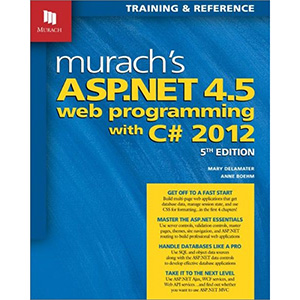
Book Description If you know how to create Windows applications using C#, you’re ready for this latest edition of our classic web programming book. It will get you off to a fast start with web programming, no matter whether you’re coming to ASP.NET 4.5 with a background in an earlier release of ASP.NET, Java servlets/JSP, PHP…or with no web background at all. In fact, by the end of chapter 5, you’ll know how to use Visual Studio 2012 to develop and test multi-page database applications for the web. But this book is much more than a beginning book. By the time you’re done, you’ll have the professional skills you need to develop bullet-proof web applications for business. You’ll also find that this book does double duty as the best on-the-job reference book that money can buy. Everything you need to know to get going on web development Look at the table of contents, and you’ll see why we say that this book covers what you need to know to develop web applications at the professional level. That includes skills like: - Managing state
- Validating input data
- Handling database data with SQL and object data sources, as well as with time-saving data controls like GridView, DetailsView, FormView, ListView, and DataPager
- Knowing how HTML5 and CSS3 fit into ASP.NET applications, so you can tweak that code as needed
- Creating user-friendly sites with master pages, themes, and site navigation features
- Using friendly URLs that improve search engine results
- Handling common frustrations, like back-button refreshes, with ease
- Deploying web applications on a remote server
- Using ASP.NET Ajax to create rich Internet applications (RIAs)
- Developing and consuming WCF and Web API services that can be hosted by one web server and used by other web sites
- Getting started with ASP.NET MVC…a whole different approach to web programming than Web Forms…so you can decide whether that’s the next step for you
Who this book is for
If you have a core set of C# programming skills…the kind you should get from any beginning book like Murach’s C# 2012…you’re ready for this book. In fact, we’re confident that it will teach you ASP.NET faster and better than any competing book. That’s true whether you’re new to web programming or whether you’re coming to it with a background in another server-side language. Table of Contents
Section 1: The essence of ASP.NET web programming
Chapter 1. An introduction to ASP.NET web programming
Chapter 2. How to develop a one-page web application
Chapter 3. How to use HTML5 and CSS3 with ASP.NET applications
Chapter 4. How to develop a multi-page web application
Chapter 5. How to test and debug ASP.NET applications Section 2: ASP.NET essentials
Chapter 6. How to use the standard server controls
Chapter 7. How to use the validation controls
Chapter 8. How to work with state, cookies, and URL encoding
Chapter 9. How to use master pages
Chapter 10. How to use themes
Chapter 11. How to use site navigation and ASP.NET routing Section 3: ASP.NET database programming
Chapter 12. An introduction to database programming
Chapter 13. How to use SQL data sources
Chapter 14. How to use the GridView control
Chapter 15. How to use the DetailsView and FormView controls
Chapter 16. How to use the ListView and DataPager controls
Chapter 17. How to use object data sources with ADO.NET Section 4: Finishing an ASP.NET application
Chapter 18. How to secure a web site
Chapter 19. How to authenticate and authorize users
Chapter 20. How to use email, custom error pages, and back-button control
Chapter 21. How to configure and deploy ASP.NET 4.5 applications Section 5: Going to the next level
Chapter 22. How to use ASP.NET Ajax
Chapter 23. How to develop WCF and Web API services
Chapter 24. An introduction to ASP.NET MVC Resources:
Appendix A. How to install and use the software and downloadable files Book Details - Series: Murach: Training & Reference
- Paperback: 856 pages
- Publisher: Mike Murach & Associates; 5th Edition (August 2013)
- Language: English
- ISBN-10: 1890774758
- ISBN-13: 978-1890774752
Note: There is a file embedded within this post, please visit this post to download the file. Related Books The post Murach’s ASP.NET 4.5 Web Programming with C# 2012, 5th Edition appeared first on Wow! eBook. |
| Murach’s Android Programming Posted: 31 Dec 2013 02:35 AM PST 
Book Description Android is arguably the world's most widely used operating system for mobile devices such as smartphones and tablets. Millions of Android devices have been activated, and billions of apps have been installed from Google Play. Since Android is open-source with a large community of developers, it is able to evolve according to the needs of the developers who use it. Now, you can be one of those developers with our book, Murach's Android Programming. All you need to get started is a basic understanding of the Java programming language, roughly equivalent to chapters 1 through 14 of Murach's Java Programming. What you can do with this book - Get set up right: Setting up an environment for Android development can be a roadblock to getting started. That's why this book shows you the easiest way to install and configure all of the software that's necessary to get started with Android development.
- Get started fast with the Tip Calculator app: Learn how to code a complete Tip Calculator app by the end of chapter 3! This app teaches you how to get input from the user, perform a calculation based on that input, and display the result on the user interface.
- Master the essential skills: Enhance the Tip Calculator app to master the skills that are critical to developing attractive and professional apps. For example, learn how to work with layouts, widgets, events, themes, styles, menus, preferences, and fragments.
- Build your skills with the News Reader app: Learn how to develop a News Reader app that reads data from the Internet without blocking the user interface. Then, learn how to use files, adapters, and intents to work with this data. In addition, learn how to create services that run in the background and how to use receivers to respond to actions that are broadcast by the system or by other apps.
- Build your skills with the Task List app: Learn how to develop a Task List app that uses a SQLite database. Then, learn how to use custom adapters, content providers, and app widgets to work with that database.
- Use the next generation of Google Maps: Version 2 of the Google Maps Android API is giving birth to a new generation of location-aware apps. This book gets you started with this powerful API and positions you to learn more on your own.
- Deploy your finished apps: When you're ready to share your app with potential users, this book shows you how to sign it with a release key and publish it to the world's most popular marketplace for Android apps, Google Play.
Who this book is for
This book is for anyone who wants to learn professional skills for developing Android apps. The only prerequisite is a basic understanding of the Java language, roughly equivalent to chapters 1 through 14 of Murach's Java Programming. Once you have the necessary Java skills, this book will work for you even if you have absolutely no experience developing mobile apps. Table of Contents
Section 1: Get started fast with Android
Chapter 1. An introduction to Android
Chapter 2. How to use Eclipse for Android development
Chapter 3. How to develop your first Android app
Chapter 4. How to test and debug an Android app Section 2: Essential Android skills
Chapter 5. How to work with layouts and widgets
Chapter 6. How to handle events
Chapter 7. How to work with themes and styles
Chapter 8. How to work with menus and preferences
Chapter 9. How to work with fragments Section 3: The News Reader app
Chapter 10. How to work with threads, files, adapters, and intents
Chapter 11. How to work with services and notifications
Chapter 12. How to work with broadcast receivers Section 4: The Task List app
Chapter 13. How to work with SQLite databases
Chapter 14. How to work with tabs and custom adapters
Chapter 15. How to work with content providers
Chapter 16. How to work with app widgets Section 5: Advanced Android skills
Chapter 17. How to deploy an app
Chapter 18. How to work with locations and maps Resources:
Appendix A. How to set up your PC for this book
Appendix B. How to set up your Mac for this book
Appendix J. How to use IntelliJ with this book Book Details - Paperback: 702 pages
- Publisher: Mike Murach & Associates (September 2013)
- Language: English
- ISBN-10: 1890774715
- ISBN-13: 978-1890774714
Note: There is a file embedded within this post, please visit this post to download the file. Related Books The post Murach’s Android Programming appeared first on Wow! eBook. |








